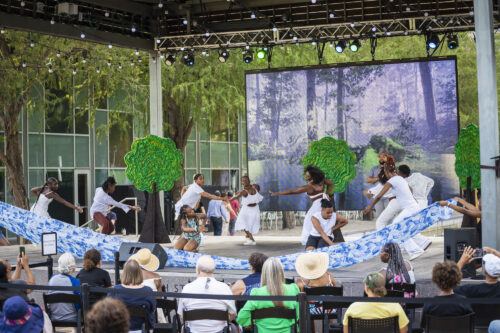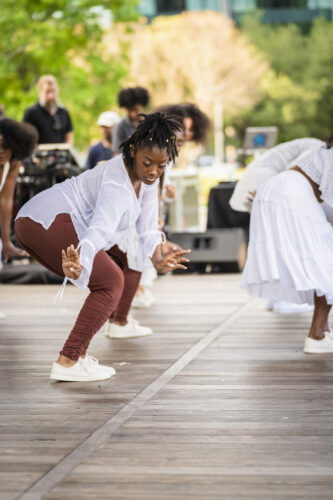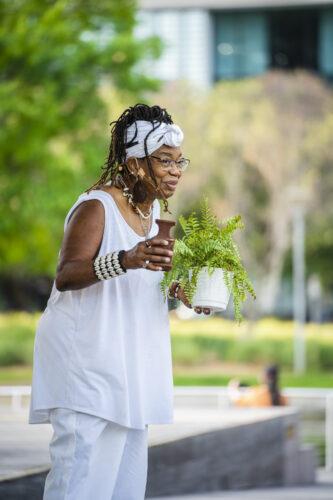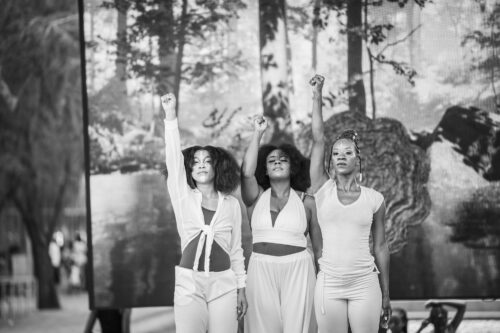The Fairytale Project Gives Texas History a New Rhythm at Discovery Green

Photo by DJ Cocroft
The power of Stacey Allen, the founder of Nia’s Daughters Movement Collective, is her ability to merge African American-Texas history, pedagogy, Diasporic African concepts and culture, with her extensive contemporary and African dance training. She does so expertly with her latest work, The Fairytale Project, a multi-disciplinary dance theater piece for children that reimagines the story of Jim and Winnie Shankle, the formerly enslaved founders of the city of Shankleville in East Texas. The show had its public premiere on June 26th, 2022 at Discovery Green’s Anheuser Busch Stage.

Photo by DJ Cocroft
When Stacey Allen first contacted me to assist The FairyTale Project as dramaturg, I was blown away researching the history of Jim and Winnie Shankle. When Winnie and her children were sold away from her lover Jim Shankle onto another plantation in East Texas, Jim escaped from his Mississippi plantation and slave owner to find her. As a student of African-American history, I know the perils Jim faced: due to the Fugitive Slave Act, Jim could have been captured and returned to his slave masters, who very well may have tortured or even killed him upon his return. Yet, it was love that kept Jim Shankle as he walked 400 miles through dangerous terrain to find her. Jim and Winnie were reunited near Winnie’s plantation, where Jim joined Winnie in enslavement until Juneteenth, when Texas enslaved persons were legally emancipated. They went on to purchase acres of land, founding the city of Shankleville, a free Black settlement in East Texas. Shankleville had mills, farms–even a college. Every year, the descendants of Jim and Winnie Shankle travel back to Shankleville to honor their legacy of love. This is a love Allen knows well, for she learned of this story through her husband who is a descendent of Jim and Winnie Shankle.
One can imagine the difficulty in trying to capture the beauty and majesty of such a powerful story, yet Stacey Allen and the Nia’s Daughters ensemble dancers were able to do so beautifully in The Fairytale Project. As a show opener, the audience was delighted by performances from younger dance proteges and students of Rising Stars Academy of Dance. Sydni Law, Symone Lewis, and Cayce Solomon were darling and talented, and they were a perfect opener for the show.

Photo by DJ Cocroft
The Fairytale Project begins with a film: a visually stunning dance poem that grounds us into the iconography of Southern Black culture and family and roots us into a Diasporic African history. The opening film features Nia’s Daughters dancers and Allen’s own lovely family and was filmed by Keda Sharber of Images By Papillon. Immediately following is the first of two moving monologues delivered from Granny Griot, (told by the masterful storyteller Sister MamaSonya), about the unbroken cultural lineages between African Americans of the Southern US and Mother Africa. It is here we are introduced to the purple hull peas as a symbolic metaphor for connectivity to the ancestors and grandma’s porch as the grounding place for this time transcending story. The audience was also given purple hull pea seeds inside a small burlap pouch to plant at home!
The two main characters are Nia and Jehlani, teen siblings who have lost the importance of family amidst their social media presences and academic aspirations. Believably portrayed by Mia Hall and Ethan Hart, Nia and Jehlani begrudgingly arrive in Shankleville too distracted by their need for wifi to appreciate returning to their ancestral home. Granny Griot decides to send them on a sankofa (a Twi word from Ghana for “go back and fetch what is at risk of being left behind) journey through time by having them shuck peas on the porch. As they begin shucking peas, they are transported back in time. This time travel sequence is accomplished with film projection, dance, flashing lights, and an expertly curated soundscape and score. They happen upon their ancestor Jim Shankle (a compelling Baba Rue Rob) just as he is tired and in danger of losing hope of finding his love Winnie (the lovely LaKendra Howard). Nia and Jehlani must help Jim reunite with Winnie or they risk their entire family being lost in time. Besides the humorous dialogue by Nia and Jehlani, the vision is woven together through the dances. The dances give the audience a visceral experience of Jim, Nia, and Jehlani wading through rivers, foraging in fields, and finally reuniting Jim with his love Winnie. One would expect these moments to be dialogue driven, but this is Allen’s genius–she uses the dialogue to get us to these moments, but the dances are where these moments come alive. Allen’s choreography is King and the dancer’s performances are Queen in this production. The music production by Andre Cunningham was a seamless complement and the costume designs by Saida Carter and Nnenna Ochuru solidified this story being interesting to children, entertaining to adults, and educational to all. The set design by Ariel Bounds brought storybook quality to the stage, while the projection landscapes by Floyd Willis brought sparkling specificity to the shifting settings.

Photo by DJ Cocroft
The implications of a show like The Fairytale Project extend far beyond just artistic entertainment for children. This show acts as a model for how dance and theater can powerfully be leveraged as a pedagogical framework for teaching history. As the state of Texas continues to grapple with the curriculum as it relates to the history of enslavement of African descendent peoples in the state, productions such as this offer a compelling way forward for educators and artists alike. There is a place for new arts-based curriculums that effectively educate and entertain at all age levels, while still being grounded in the historicity of those freedom stories often buried. If anyone wanted to know the importance of this piece, one would only have to look at the descendants of Jim and Winne Shankle who attended and joined the stage at the end of the show. Their faces, some with tears, were full of pride and honor to see their beloved family legacy honored. If art is measured by its impact, The Fairytale Project is art at its finest.



Recent Comments